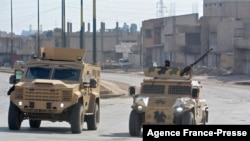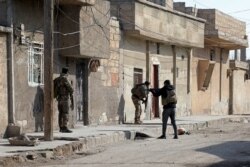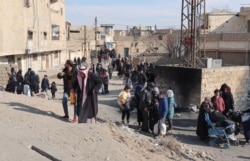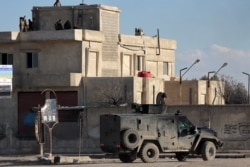A massive and well-planned operation by the Islamic State to free thousands of the terror group’s fighters from a prison in northeastern Syria is over, more than six days after the attack plunged the facility and surrounding neighborhoods into chaos.
The U.S.-backed Syrian Democratic Forces (SDF) announced Wednesday they had taken full control of the al-Sina’a prison in Hasakah, a make-shift detention facility that housed an estimated 4,000 IS fighters, as well as about 700 to 850 boys and teenagers from IS families.
"The Peoples' Hammer Operation has culminated with our entire control of the al-Sina'a prison in al-Hasakah and the surrendering of all Daesh terrorists," SDF spokesman Farhad Shami tweeted, using the Arabic acronym for the terror group.
Prior to the announcement, SDF officials said overnight operations had freed an additional 23 workers from the prison who were being held as hostages, and that at least 1,000 prisoners had surrendered or had been recaptured.
Shami told VOA that 250 IS attackers had been killed, and that thousands of the prison’s inmates had been recaptured, according to initial estimates.
"Had the safety of the children not been our major concern, we could have finished this operation in one to two days with heavy weapons," he added.
Shami also said the SDF was looking into the fate of the children, who had been kept in a separate part of the al-Sina’a prison facility, acknowledging some were likely injured.
SDF officials said early on that IS attackers and prisoners had been using the children as human shields.
On Tuesday, Human Rights Watch said it had spoken to an Australian boy who had been caught up in the fighting, saying he had been wounded during the SDF effort to retake the prison and that he saw other boys shot and killed.
"I was just sitting in my cell and an explosion happened," he told HRW. “I ran out with my friends and on the way my friends got killed in front of me a 14 year old, a 15 year old."
HRW Associate Director Letta Tayler Wednesday called on the SDF to provide an update on the children, noting evidence heavy weaponry had been used in the operation to retake the prison.
“We deeply share your concerns about the safety and well-being of the children [sic],” the SDF responded. “We are doing our best to provide the most accurate information for the public in the earliest convenience.”
The assault on the al-Sina’a prison in Hasakah began this past Thursday night when, according to the SDF, about 300 IS operatives set-off multiple car bombs and converged on the facility.
The attack sparked days of intense fighting in and around the prison, with the SDF calling in about 10,000 troops for the operation to secure the area.
U.S. and coalition forces also assisted in the effort, carrying out airstrikes from F-16 jets and with Apache attack helicopters. U.S. Bradley Fighting Vehicles also were sent to the prison, occasionally firing on IS position as they helped the SDF secure the perimeter.
A U.S. official, speaking to VOA on the condition of anonymity in order to discuss the operation, said the U.S. efforts helped the SDF establish both an inner cordon and an outer cordon around the prison.
"We are still providing a measure of support to the SDF to help to contain this threat," Pentagon press secretary John Kirby told reporters, separately, on Tuesday. "We helped them establish a perimeter around this facility.”
Some 30 SDF soldiers were killed in the operation to retake the prison. Several civilians were also killed, the SDF blaming their death on IS, saying at least one person was beheaded by IS fighters trying to gain access to a residence outside of the prison complex.
On Wednesday, SDF officials sought to downplay concerns that the nearly week-long IS attacks allowed prisoners to escape.
“Reports that tens or hundreds of ISIS prisoners ran away, that is not correct,” the SDF’s Farhad Shami told VOA, using another acronym for the terror group.
"There may be individual escapes … but no mass escape from the prison,” he said.
But numbers released by the SDF later Wednesday, and shared with the Rojava Information Center, a pro-Kurdish research group, indicated the fate of about 2,200 prisoners and most of the 700 children, was still unknown.
Separately, the U.S. official told VOA on Tuesday that early estimates had the number of escapees in the 10-20 range.
Western counterterrorism officials and analysts have warned the attack on al-Sina’a could be the first in a series of new offensives by IS in Syria and Iraq, believed to have as many as 10,000 fighters.
“This was clearly part of a more deliberate campaign,” Colin Clarke, director of policy and research at the global intelligence firm The Soufan Group, told VOA. “It's not one that was designed overnight.”
“We're going to see more sophisticated assaults, multi-pronged attacks against vulnerable prisons until ISIS feels like it's recouped and restocked its organization with the requisite amount of fighters,” he added.
Humanitarian groups are also expressing alarm, though many agree the deadly IS prison break should not come as a surprise.
"I do strongly hope that this will serve as a wake-up call, drawing renewed attention to a situation that is totally unsustainable,” Dominik Stillhart, the director of operations for the International Committee of the Red Cross, told reporters Wednesday.
“What is happening in the northeast of Syria, with this essentially stranded population — not just the 10,000 people living in places of detention, but also the nearly 60,000 that are in the camps, in particular al-Hol — is not a sustainable solution,” he said. “Obviously, it is also a place that is fertile ground for further radicalization.”
The SDF Wednesday called on the international community to help, both with prisons and with repatriation of foreign IS fighters.
"We urgently need new prisons, larger, safer and far from residential areas,” the SDF’s Farhad Shami told VOA. “These prisons [in Hasakah] are no longer useable … this is almost an urgent matter now.”
In a statement Sunday, the U.S.-led coalition said the IS attack "attempted to destroy a new, more secure detention facility in Hasakah" being built not far from the current prison "but failed."
On Wednesday, Coalition Commander, Major General John Brennan, admitted more work needs to be done to contain the reemerging threat from IS.
“This is not a problem solely within this city,” Brennan said in a statement. "The makeshift prisons throughout Syria are a breeding ground for Daesh's failed ideology... This is a global problem that requires many nations to come together to develop an enduring long-term solution."
VOA's Margaret Besheer contributed to this story.












